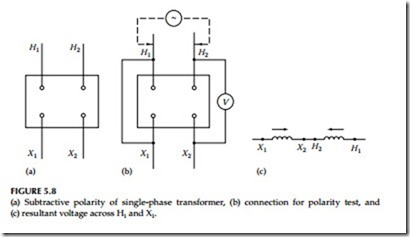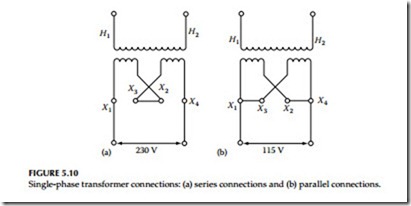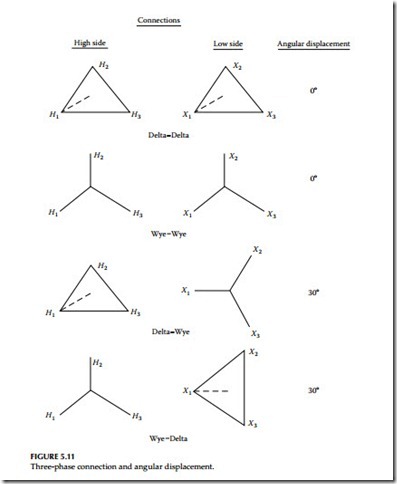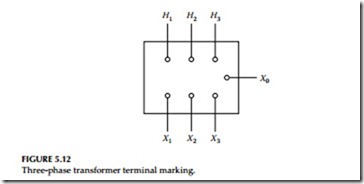Transformer Polarity, Terminal Markings, and Connections
Single-Phase Transformers
Primary and secondary terminals of a single-phase transformer have the same polarity when the current enters the primary terminal and at the same time leaves the secondary terminal. Transformers are constructed with subtractive and additive polarities.
When the high-side lead, H1 and low-side lead, X1, are brought out on the same side of the transformer, the polarity is said to be subtractive, as shown in Figure 5.8a. If leads H1 and X1 are connected and the high side is energized with a given voltage, the resulting voltage, which appears across the H2 and X2 leads, will be less than the applied voltage (see Figure 5.8b). This is due to the fact that in this series connection the low-voltage winding opposes
(a) Subtractive polarity of single-phase transformer, (b) connection for polarity test, and (c) resultant voltage across H1 and X1.
the high-voltage (HV) winding, and thus the low voltage is subtracted from the HV (see Figure 5.8c).
Additive Polarity
When the high-side lead, H1, and low-side lead, X2, are brought out on the same side of the transformer, the polarity is said to be additive. If the leads H1 and X2 are connected and a given voltage is applied to the high side, the resultant voltage across the H2 and X1 leads is the sum of the high- and low- voltage windings. Additive polarity is shown in Figure 5.9.
In general, polarity is not indicative of a higher or lower arrangement of potential stresses within a transformer or arrangement of windings. Both sub- tractive and additive polarities are found in transformers. Additive polarity is more prevalent in distribution-type transformers and subtractive polarity in power transformers.
The connections of single-phase distribution transformers usually have their windings divided into two or more sections. When the two secondary wind- ings are connected in parallel, their currents add, and if the two windings are connected in series, their voltages add. The connection output is the same in both cases: for example, for series connection each secondary winding rated at 115 V and 100 A, therefore the output is equal to 230 × 100 = 23,000 VA or 23 kVA; and for parallel connection it is equal to 115 × 200 = 23,000 VA or 23 kVA. These connections are shown in Figure 5.10.
Three-Phase Transformers
The polarity of three-phase transformers is fixed by the connections between phases, as well as by the relative locations of leads, and can be designated by a sketch showing lead markings and a vector diagram showing the electrical
angular shift between terminals. The basic three-phase transformer configu- rations are as follows:
Delta–delta Wye–wye (star–star) Delta–wye (star) Wye (star)–delta These connections are shown in Figure 5.11. The standard angular displace- ment between reference phases of a delta–delta bank or a star–star bank is 0°. The standard angular displacement between reference phases of a star–delta or a delta–star bank is 30°. The American National Standards Institute (ANSI) standard C57.12 stipulates that for such three-phase banks the HV reference phase angle is 30° ahead of the reference low voltage, regardless of whether the bank connections are star–delta or delta–star.
The lead marking of three-phase transformers has been standardized by ANSI and NEMA for the purpose of paralleling operation. The HV lead H1 is brought out on the right side when facing the HV side of the trans- former case. The remaining HV side leads H2 and H3 are brought out and numbered in sequence from right to left. The low-voltage side lead, X1 is brought out on the left side facing the low side of the transformer case. The remaining low-voltage side leads, X2 and X3, are numbered in sequence from left to right. This is shown in Figure 5.12.
The four basic three-phase transformer configurations can be accom- plished by connecting three single-phase transformers or by connecting three-phase windings within one tank. All the configurations provide symmetrical connections. The relationship between each phase for high- and low-side voltage is 120°, as shown in the vector diagrams of Figure 5.13a and b. There are many other connections that give different phase displacement, and the reader is urged to review a text on transformer connections.
For parallel operation of single- or three-phase transformers, it is essential that certain conditions be maintained. For example, when placing single- phase transformers in parallel, it is important to have the same voltage ratios and impedances. Similarly, the like polarities of each transformer must be connected together when placing single-phase transformers in parallel. One should be very careful in paralleling transformers, because many problems
can arise if proper consideration is not given to the transformer connections and characteristics. Some of the problems in paralleling transformers that require careful analysis are the following:
Paralleling transformers having different winding connections Transformers with different impedances or turns ratio or different
primary voltages
Transformers of different polarity and phase displacement The reader is urged to consult a transformer text before paralleling transformers.
Related posts:
Incoming search terms:
- power transformer test equipment mail
- Transformer mail
- marking three phase phase transformer terminals
- transformer TERMINAL connections
- additive and subtractive polarity of transformer
- polarity marking of transformer
- additive polarity
- transformer terminal marking
- power transformer mail
- instrument transformers polarity marks
- transformer terminal markings
- Transformer marked N48-9534 PT
- state additive polarity
- important of polarity marking
- importance of terminal marking
- transformer terminals
- describe the method of marking the terminals of 3 phase transformer
- how warkings transformer
- High voltage electrical transformers
- Transformers instrument mail
- polarities of 1 phase trans
- Eletrical transformer mail
- transformer terminal arrangement
- connection diagram of single phase Transformer with polarity
- what are the standard terminal markings on transformer
- transformer markings
- Labelling and marking machinery and equipment mail
- additive and subtractive property of transformer
- additive and subtractive polarity
- Instrument transformers mail
- australian phase markings for transformers
- australian standard symbol for transformer polarity
- how to mark the terminal in additive polarity of 1phase transformer
- ac transformer output wire hash marks
- https://yandex ru/clck/jsredir?from=yandex ru;search;web;;&text=&etext=1824 HLHkkRB4ay6xf31wULEbL7ojWyCSW1BM6Czp_IjJQMvbO07JrJpcwkadov4lkctaRiUjnEF6o91xFsKOt16gTg 8266e467903d1de071f2742dcfdcac6a59c27145&uuid=&state=_BLhILn4SxNIvvL0W45KSic
- identifying transformer polarity
- if the secondary terminal of the wrong polarity are connected when paralleling transformer
- importance of correct polarity marking of transformers
- CONTROL TRANSFORMERS mail
- additive transformers
- components for identification of polarity of a 3 phase transforme
- current transformer terminals
- default phase marking for 3-phase current
- yhsm-inucbr_001
- distribution transformer polarity
- Distribution Transformers mail
- ct polarity color
- ansi standard for transfortmer markings
- All phases of a 3-phase transformer have the same relative polarity
- Additive type transformer




